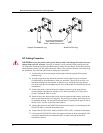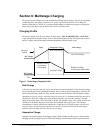
Prosine Inverter Load Sense Mode
56 Prosine 2.5/3.0 Installation & Operation Guide
Prosine Inverter Load Sense Mode
When the inverter is ON, it can be set up so that it periodically searches for the presence of a load. The
unit will “sleep” if the load it detects is less than the search mode setting. This “sleep” mode shuts off
much of the power control circuitry of the Prosine inverter/charger, reducing the standby current draw
considerably. The Prosine inverter/charger detects the presence of a load by sending out pulses
depending on user settings. Full output power is available with the detection of a load. You can set the
minimum load required to start the inverter, by either changing the configuration DIP switches on the
side of the chassis, or using the ACS Panel (Advanced Control System Panel). The INVERT LED will
blink approximately once per second when the Prosine inverter/charger is in this search mode. There
are four choices for the setting of the minimum load start power when using the chassis DIP switches
(the ACS Panel offers a much wider range of load start-power settings):
Operating Limits for Inverter Operation
Power Output:. The invert mode output rating for your Prosine inverter/charger is:
Prosine 2.5 = 2500 watts or 21 amps @ 120VAC; surge to 4kw
Prosine 3.0 = 3000 watts or 25 amps @120VAC; surge to 4kw
The units should be able to operate all AC loads rated at or below their respective power ratings. Some
high horsepower induction motors used in pumps and other motor operated equipment require very
high surge currents to start and the Prosine inverter/charger may have difficulty starting these loads. If
you have problems with the Prosine inverter/charger starting certain loads, ensure that battery
connections are solid, DC and AC wiring is of sufficient size, and that the battery is of sufficient
capacity and fully charged.
Setting
Description
0 watts Inverter always on, search mode disabled
10 watts
25 watts
50 watts
Set to the load rating that you want the inverter
to power. Example Set at 50-watts, a 75-watt
light bulb will activate the inverter; a 25-watt
bulb will not activate inverter.


















